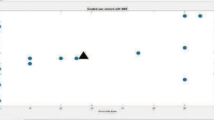Abstract
In recent years Internet of Things (IoT) attracts a significant attention in fifth generation (5G) networks. 5G network is considered for its high speed and large number of user equipments (UEs). Non-orthogonal multiple access (NOMA), an information theoretic approach, has been considered in 5G to support large UEs as well as with many other benefits. As a result, different objectives such as energy efficiency (EE), spectral efficiency (SE), and user fairness (UF) have to be taken care of. In this paper, we aim to focus on improving SE and EE while maintaining UF. This paper presents multi-objective optimization (MOO) using genetic algorithm (GA) with the help of reinforcement learning (RL) algorithm. This work focuses on improving the sum rate as well as energy efficiency assuming perfect channel state information (CSI). Most of the work focuses on gradient-based algorithm, namely, backpropagation while Evolution strategies can rival gradient-based algorithm. In this work, we omit the use of backpropagation and replace it with genetic algorithm. It is a challenging task when considering long-term reward maximization in the network. Reinforcement learning with Markov decision process (MDP) help in this direction.
Access this chapter
Tax calculation will be finalised at checkout
Purchases are for personal use only
Similar content being viewed by others
References
Riazul Islam SM et al (2017) Power-domain non-orthogonal multiple access (NOMA) in 5G systems: potentials and challenges. IEEE Commun Surv Tutor 19(2):721–742. https://doi.org/10.1109/COMST.2016.26211
Choi J (2016) Power allocation for max-sum rate and max-min rate proportional fairness in NOMA. IEEE Commun Lett 20(10):2055–2058. https://doi.org/10.1109/LCOMM.2016.2596760
Manglayev T, Kizilirmak RC, Kho YH (2016) Optimum power allocation for non-orthogonal multiple access (NOMA). In: 2016 IEEE 10th international conference on application of information and communication technologies (AICT), pp 1–4. https://doi.org/10.1109/ICAICT.2016.7991730
Sindhu P, Deepak KS, Abdul Hameed KM (2018) A novel low complexity power allocation algorithm for downlink NOMA networks. In: 2018 IEEE recent advances in intelligent computational systems (RAICS), pp 36–40. https://doi.org/10.1109/RAICS.2018.8635048
Glei N, Chibani RB (2019) Power allocation for energy efficient downlink NOMA systems. In: 2019 19th international conference on sciences and techniques of automatic control and computer engineering (STA), pp 611–613. https://doi.org/10.1109/STA.2019.8717240
Fang F et al (2016) Energy-efficient resource allocation for downlink non orthogonal multiple access network. IEEE Trans Commun 64(9):3722–3732. https://doi.org/10.1109/TCOMM.2016.2594759
Zhang Y et al (2017) Energy-efficient transmission design in non-orthogonal multiple access. IEEE Trans Veh Technol 66(3):2852–2857. https://doi.org/10.1109/TVT.2016.2578949
Wang J et al (2018) Energy-efficient joint power and bandwidth allocation for NOMA systems. IEEE Commun Lett 22(4):780–783. https://doi.org/10.1109/LCOMM.2018.2794521
Hongyun X (2018) An improved PSO-based power allocation algorithm for the optimal EE and SE tradeoff in downlink NOMA systems. In: IEEE 29th annual international symposium on personal, indoor and mobile radio communications (PIMRC), pp 1–5. https://doi.org/10.1109/PIMRC.2018.8580928
Ni D et al (2018) Energy-spectral efficiency tradeoff of downlink NOMA system with fairness consideration. In: 2018 IEEE 87th vehicular technology conference (VTC Spring), pp 1–5. https://doi.org/10.1109/VTCSpring.2018.8417647
Liu Q et al (2017) Energy efficiency and spectral-efficiency tradeoff in down link NOMA systems. In: 2017 IEEE international conference on communications workshops (ICC Workshops), pp 247–252. https://doi.org/10.1109/ICCW.2017.7962665
Zuo Y et al (2018) Energy efficiency and spectral efficiency tradeoff for multicarrier NOMA systems with user fairness. In: 2018 IEEE/CIC international conference on communications in China (ICCC), pp 666–670. https://doi.org/10.1109/ICCChina.2018.8641176
Nguyen K-H et al (2021) Rate fairness and power consumption optimization for NOMA-assisted downlink networks. Energies 14(1). ISSN: 1996-1073. https://doi.org/10.3390/en14010058. https://www.mdpi.com/1996-1073/14/1/58
Kim IY, de Weck OL (2006) Adaptive weighted sum method for multiobjective optimization: a new method for Pareto front generation. Struct Multidiscipl Optim 31:105–116
Konak A, Coit DW, Smith AE (2006) Multi-objective optimization using genetic algorithms: a tutorial. Reliab Eng Syst Safety 91(9). Special Issue - Genetic Algorithms and Reliability, pp 992–1007. ISSN: 0951-8320. https://doi.org/10.1016/j.ress.2005.11.018. https://www.sciencedirect.com/science/article/pii/S0951832005002012
Bui LT, Alam S (2008) Multi-objective optimization in computational intelligence: theory and practice: theory and practice. IGI Global
Lin JGG (2005) On min-norm and min-max methods of multi-objective optimization. Math Program 103(1):1–33
Prameela Devi R, Prabakaran N (2022) Hybrid cuckoo search with salp swarm optimization for spectral and energy efficiency maximization in NOMA system. Wirel Pers Commun 124(1):377–399
Sutton RS, Barto AG (2018) Reinforcement learning: an introduction. MIT Press
Mandischer M (2002) A comparison of evolution strategies and backpropagation for neural network training. Neurocomputing 42(1–4):87–117
Author information
Authors and Affiliations
Corresponding author
Editor information
Editors and Affiliations
Rights and permissions
Copyright information
© 2023 The Author(s), under exclusive license to Springer Nature Singapore Pte Ltd.
About this paper
Cite this paper
Majhi, S., Mitra, P. (2023). Multi-objective Optimization in NOMA-IoT Networks. In: Bhattacharjee, R., Neog, D.R., Mopuri, K.R., Vipparthi, S.K. (eds) Artificial Intelligence and Data Science Based R&D Interventions. NERC 2022. Springer, Singapore. https://doi.org/10.1007/978-981-99-2609-1_6
Download citation
DOI: https://doi.org/10.1007/978-981-99-2609-1_6
Published:
Publisher Name: Springer, Singapore
Print ISBN: 978-981-99-2608-4
Online ISBN: 978-981-99-2609-1
eBook Packages: Computer ScienceComputer Science (R0)




